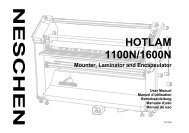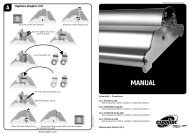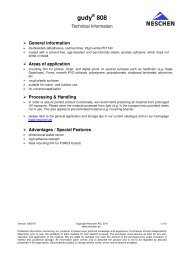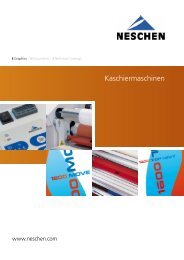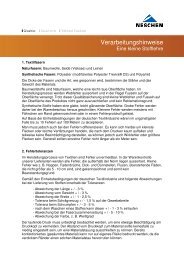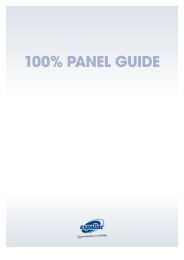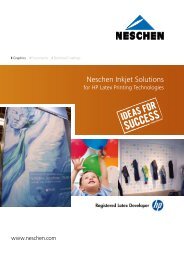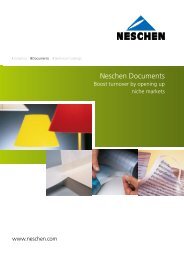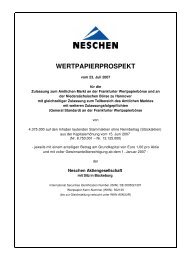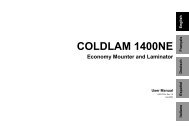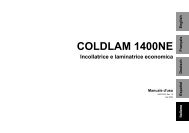COLDLAM/HOTLAM TH 1100N/1600N/2000N Mounter ... - Neschen
COLDLAM/HOTLAM TH 1100N/1600N/2000N Mounter ... - Neschen
COLDLAM/HOTLAM TH 1100N/1600N/2000N Mounter ... - Neschen
You also want an ePaper? Increase the reach of your titles
YUMPU automatically turns print PDFs into web optimized ePapers that Google loves.
4.5.2 Pre-coating panels<br />
This process is used to coat boards (substrates) with a<br />
pressure sensitive mounting film onto which images can be<br />
mounted. This process can also be used to create a carrier<br />
board.<br />
Note:<br />
Mounting film is usually provided with one release liner.<br />
Place the film and web it as if it is without release liner, over<br />
the splitter bar.<br />
1. Place the roll of mounting film on the shaft of the upper<br />
unwind position.<br />
2. Set the nip to correspond to the thickness of the panels to<br />
process.<br />
3. Web the film using a leader board of the same material,<br />
thickness and width.<br />
4. Set the pressure while feeding the leader board.<br />
5. Before the end of the leader board enters the nip, butt up<br />
the panel to be pre-coated.<br />
When more panels have to be pre-coated feed them in<br />
continuously without any gap.<br />
At the end, use a leader board again to finish. This is to<br />
prevent the adhesive to touch the bottom roller.<br />
6. Butt up and feed the ending leader board until the previous<br />
panel is out of the nip.<br />
CAUTION:<br />
Do not cut film close to or on the rollers. This will<br />
damage the silicone coating of the rollers and will<br />
void the warranty.<br />
7. Cut this panel free.<br />
8. Back-up the leader board using the reverse.<br />
9. Cut the film using a blade cutter.<br />
After removing the release liner from the pressure sensitive<br />
mounting adhesive, the board has an adhesive coating ready<br />
to mount an image. See section 4.5.1 for mounting images.<br />
4.5.3 Single-sided lamination<br />
Images are laminated single-sided using carrier (or release)<br />
boards. This laminate can be a heat sensitive laminate or a<br />
pressure sensitive adhesive with release liner.<br />
• The image is put on the carrier board with the image up.<br />
• All steps in this process are equal to steps when precoating<br />
a board (section 4.5.2).<br />
4.5.4 Over-lamination<br />
After an image is mounted to a panel, a protective laminate<br />
can be applied. This over-laminate can be a heat sensitive<br />
laminate or a pressure sensitive adhesive with release liner.<br />
• All steps in this process are equal to steps when precoating<br />
a board (section 4.5.2).<br />
4.5.5 Double-sided lamination<br />
Encapsulating images with cold laminates is called doublesided<br />
lamination (and is normally not done with panels).<br />
On a standard machine (shafts only present in the upper<br />
section), double-sided lamination is done by performing<br />
single-sided lamination twice using a carrier board.<br />
The image side is laminated first. Then the image is put<br />
upside down on the carrier board and laminated again.<br />
Operating 27<br />
English




